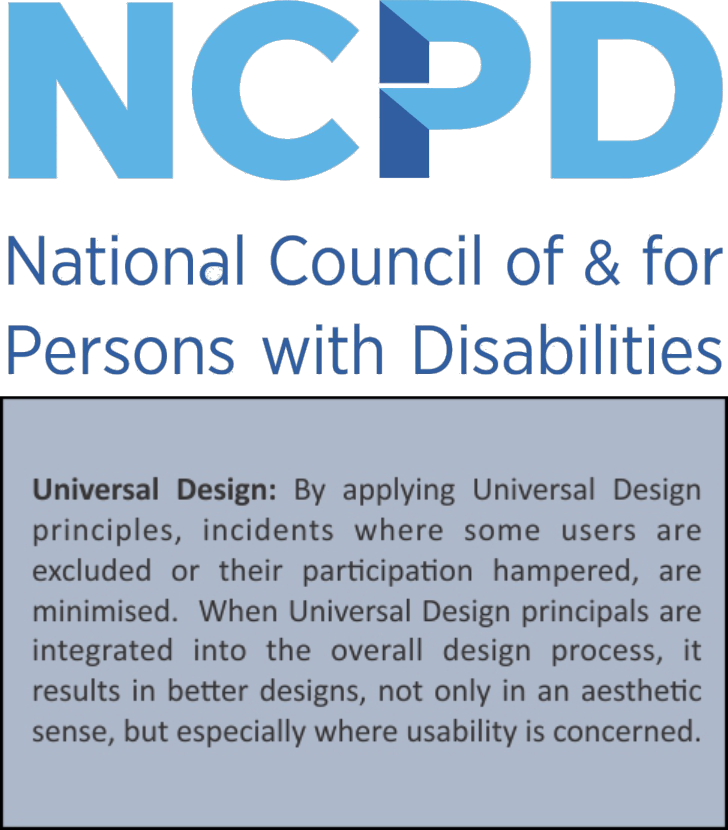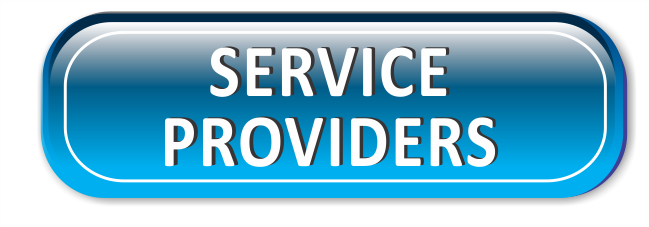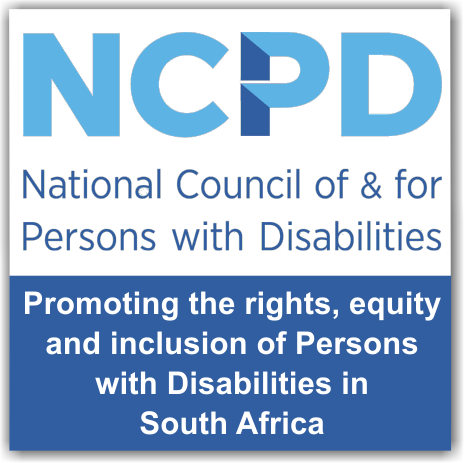Signage
Introduction
The International Symbol of Access (ISA), also known as the (International) Wheelchair Symbol, consists of a blue square overlaid in white with a stylized image of a wheelchair. It is maintained as an international standard, ISO 7001 image of the International Commission on Technology and Accessibility (ICTA).
The symbol is often seen where access has been improved, particularly for wheelchair users, but also for other disability issues. Frequently, the symbol shows the removal of environmental barriers, such as steps, to help the disabled, elderly, parents with baby carriages, and travellers. Universal design aims to obviate such symbols by creating products and facilities that are accessible to nearly all users from the start. The wheelchair symbol is "International" and therefore not accompanied by Braille in any particular language.
Specific uses of the ISA include:
- Marking a parking space reserved for vehicles used by people with disabilities/blue badge holders
- Marking a vehicle used by a person with a disability, often for permission to use a space
- Marking a public lavatory with facilities designed for wheelchair users
- Indicating a button to activate an automatic door
- Indicating an accessible transit station or vehicle
- Indicating a transit route that uses accessible vehicles
The South African National Standard for Building Regulations
Providing clear and visible marking by using this accessible disabled sign is essential in making facilities visible for those who need them. The South African Government through The South African National Standard for Building Regulations therefore makes laws that insure that new buildings are designed & built with certain regulations, which includes regulations on Signage.
Facilities that are included in a building specifically for use by persons with disabilities, such as wheelchair-accessible parking spaces, wheelchair-accessible toilets, and platform or stair lifts, shall be indicated by the international symbol for access.
Unfortunately many buildings in South Africa still do not have adequate signage, the owners of these buildings and houses may therefore need advice from Organizations and Companies that specialize in Universal Design and Access. There are various Organizations and Companies that can assist with Universal Design and Access to make sure that persons with disabilities are not excluded from any events, services, information, communication, products and venues.
Organizations & Companies That Can Assist With Universal Design & Access
There are now various Organizations and Companies that specialize in Universal Design and Access and can advise you on how to include compliant signage to make sure that persons with disabilities have equal rights and no loss of dignity. The National Council of and for Persons with Disabilities (NCPD), Bradshaw LeRoux Consulting, The QuadPara Association of South Africa (QASA) and DiSA specialize in Universal Design and Access to make sure that persons with disabilities are not excluded from any events, services, information, communication, products and venues. These Organizations and Companies can assist in different ways including:
The National Council of and for Persons with Disabilities (NCPD): believe that this can be prevented by applying Universal Design Principals during the design phase and they therefor offer the following services to assist:
- Workshops for architects, developers and other building professionals to develop an understanding of universal design and access.
- Facilitating access audits for new or existing buildings; echo e-access for the natural and communication environment. Audits are followed by a report indicating shortfalls and recommendations.
- Marketing of facilities that are accessible to persons with disabilities
Contact Fanie Swanepoel or Danie Marais for more information on Tel: +27 11 452 2774 or email them on: fanies@ncpd.org.za or danie@ncpd.org.za
QASA: The QuadPara Association of South Africa (QASA) is a non-profit organisation (NPO 000-881) of Quadriplegics and Paraplegics in South Africa. QASA’s mission is “to improve lives by securing resources to advocate, educate, capacitate, support and mobilize”. QASA’s vision is that “all quadriplegics and paraplegics will live their lives to their full potential”. QASA develops products, programmes and services for quadriplegic and paraplegic members to build their capacity and ensure opportunities for societal integration and empowerment.
will live their lives to their full potential”. QASA develops products, programmes and services for quadriplegic and paraplegic members to build their capacity and ensure opportunities for societal integration and empowerment.
These Services include but are not limited to Access Audits:
An access audit is a form of inspection that can be used to assess the ease of access to, and ease of use of an environment (such as a building or landscape), a service, or a facility, by people with a range of access impairments.
Everyone has the right to be able to fully participate within society, and the built environment and accessibility plays a vital role in achieving this goal. Persons with mobility impairments are faced with physical barriers that exclude them from societal integration, be that in the workplace, educational & recreational facilities.
Bearing this in mind it is of utmost importance that we make our spaces accessible, it is not only an issue of equality and justice, but it makes good business sense, and adds to contributing to the development of a more inclusive and equal society.
Access Audits identify features including:
- The current accessibility of the building
- Areas for improvement (e.g. no accessible parking in the car park or the door in the accessible toilet on the ground floor is incorrectly located and therefore the building is inaccessible)
- Good/bad practice in relation to facilities management that an organisation has in place; positive accessibility features (e.g. counter tops at reception, good use of lighting and colour throughout building, signages)
Benefits of Accessible Environment:
- Increases the pool of potential new employees that an employer can tap into
- Retain existing employees who may acquire a disability through an accident / medical condition
- Enables more persons with disabilities to enter the building and /or use the services
- Improves overall safety of buildings, which has a direct impact on the number of accidents taking place and therefore the cost of insurance premiums.
Click on the link above to find out more about "Access Audits", or visit our Organizations - QASA Page to find out more about QASA and the other Projects and Services that they provide, or their website at www.qasa.co.za.
These Organizations and Companies listed above which specialize in Universal Design and Access will follow those standards set by "The National Building Regulations and Building Standards Act" to make sure that all signage is accessible to persons with disabilities.
Signage Regulations
4.2 Signage
4.2.1 Facilities that are included in a building specifically for use by persons with disabilities, such as wheelchair-accessible parking spaces, wheelchair-accessible toilets, and platform or stair lifts, shall be indicated by the international symbol for access and shall comply with 4.2.2 and 4.2.4. The international symbol shall be exhibited
- at the main entrance of, and at any other suitable position in, a building, and
- in suitable positions to indicate to persons with disabilities the route to the exit of such facilities.
4.2.2 The sign used to indicate facilities provided for persons with disabilities shall be the SANS 1186-1 type designation GA 22 (allocated to or accessible to wheelchairs) sign. Such signage shall comply with the requirements of SANS 1186-1 and shall have a symbol height of not less than 110 mm.
4.2.3 Facilities that are not in accordance with the requirements of this part of SANS 10400 shall not bear the international symbol.
NOTE 1: The symbol is the property of the International Standards Office and its use can only be sanctioned where the minimum requirements of the National Building Regulations have been complied with.
NOTE 2: Signs should be in clear, visible and tactile format to ensure that persons with visual impairments are also fully informed. In buildings where persons with visual impairments work or live, evacuation instructions in large print and Braille should be provided, so that persons with visual impairments can familiarize themselves with escape routes.
4.2.4 Clear legible signs shall indicate the direction and name of an accessible facility and shall incorporate the international symbol. The height of the lettering shall not be less than 50 mm.
Where the viewing distance is greater than 10 m, the height of the lettering shall be increased accordingly (see table 1).
Table 1 — Height of lettering in relation to viewing distance
| Viewing distance meters | Height mm |
| 25 | 80 |
| 30 | 100 |
| 40 | 140 |
| 50 | 160 |
To enable persons with impaired vision to read location signs adjacent to doors or directional signs on walls, the signs should be placed at a height of between 1,4 m and 1,7 m above finished floor level.
NOTE Raised letters and symbols, in contrasting light and dark colours, on identification or location signs assist those who are blind or have impaired vision.
All internal signage to indicate escape routes in case of total blackout shall comply with the requirements of SANS 10400-T.
4.2.5 For demarcating parking areas for wheelchair users, signs should be not less than 2,0 m vertically above driveway level, so that the sign can be seen whilst driving a car.
4.2.6 Where electronic aids are installed to assist persons with hearing loss, a suitable sign shall be displayed to indicate such facilities.
4.2.7 Any mark or sign shall comply with the relevant requirements of SANS 1186-1.
Links
- Building Regulations for facilities for Disabled Pdf.
- Standard Electrical, Mechanical And Architectural Guideline For The Design Of Accessible Buildings (Facilities For Disabled Persons)
To find Companies and Organizations that can assist you, visit our "Services & Service Providers" Search Facility on the following link: http://disabilityinfosa.co.za/search-for-info/services/. If you require any Products listed on this page, visit our "Products" search facility: http://disabilityinfosa.co.za/search-for-info/products-equipment/




